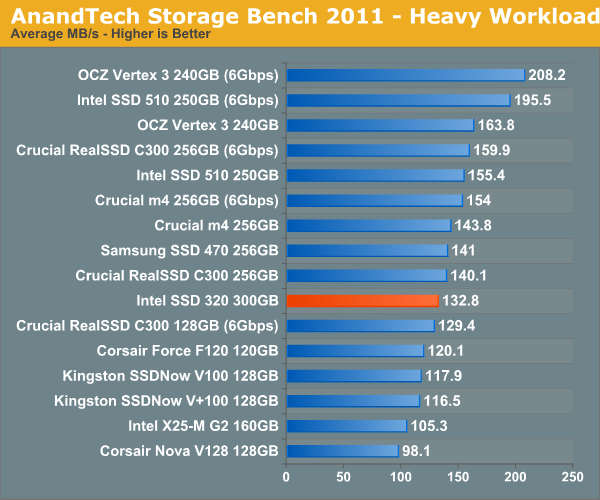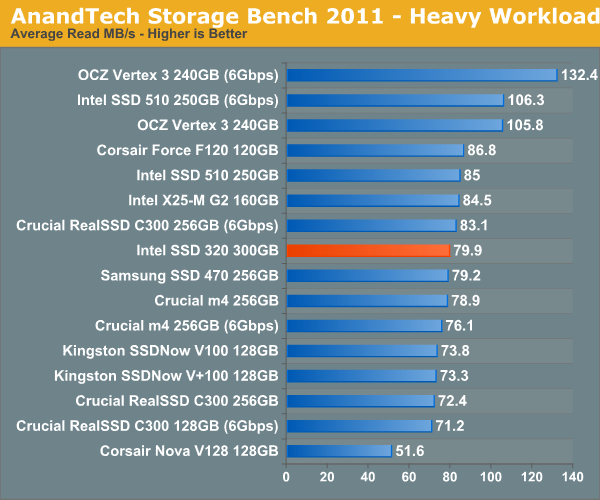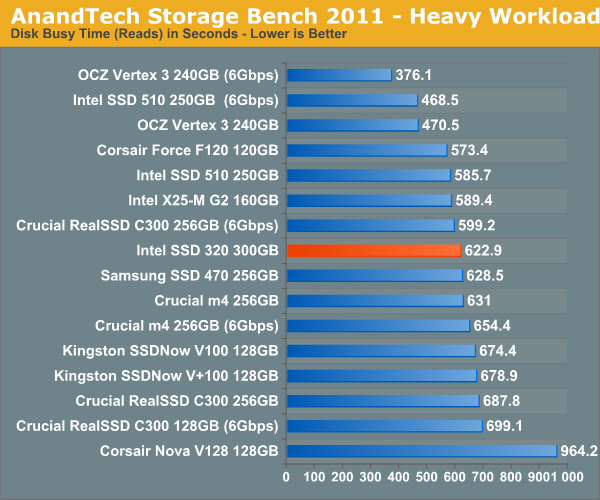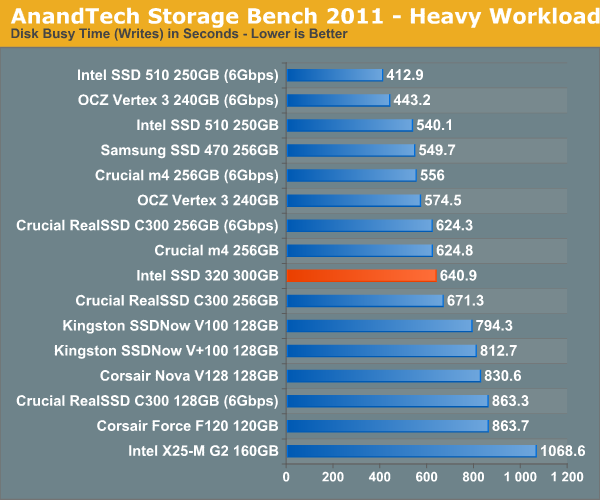The Intel SSD 320 Review: 25nm G3 is Finally Here
by Anand Lal Shimpi on March 28, 2011 11:08 AM EST- Posted in
- IT Computing
- Storage
- SSDs
- Intel
- Intel SSD 320
AnandTech Storage Bench 2011: Much Heavier
I didn't expect to have to debut this so soon, but I've been working on updated benchmarks for 2011. Last year we introduced our AnandTech Storage Bench, a suite of benchmarks that took traces of real OS/application usage and played them back in a repeatable manner. I assembled the traces myself out of frustration with the majority of what we have today in terms of SSD benchmarks.
Although the AnandTech Storage Bench tests did a good job of characterizing SSD performance, they weren't stressful enough. All of the tests performed less than 10GB of reads/writes and typically involved only 4GB of writes specifically. That's not even enough exceed the spare area on most SSDs. Most canned SSD benchmarks don't even come close to writing a single gigabyte of data, but that doesn't mean that simply writing 4GB is acceptable.
Originally I kept the benchmarks short enough that they wouldn't be a burden to run (~30 minutes) but long enough that they were representative of what a power user might do with their system.
Not too long ago I tweeted that I had created what I referred to as the Mother of All SSD Benchmarks (MOASB). Rather than only writing 4GB of data to the drive, this benchmark writes 106.32GB. It's the load you'd put on a drive after nearly two weeks of constant usage. And it takes a *long* time to run.
I'll be sharing the full details of the benchmark in some upcoming SSD articles but here are some details:
1) The MOASB, officially called AnandTech Storage Bench 2011 - Heavy Workload, mainly focuses on the times when your I/O activity is the highest. There is a lot of downloading and application installing that happens during the course of this test. My thinking was that it's during application installs, file copies, downloading and multitasking with all of this that you can really notice performance differences between drives.
2) I tried to cover as many bases as possible with the software I incorporated into this test. There's a lot of photo editing in Photoshop, HTML editing in Dreamweaver, web browsing, game playing/level loading (Starcraft II & WoW are both a part of the test) as well as general use stuff (application installing, virus scanning). I included a large amount of email downloading, document creation and editing as well. To top it all off I even use Visual Studio 2008 to build Chromium during the test.
Many of you have asked for a better way to really characterize performance. Simply looking at IOPS doesn't really say much. As a result I'm going to be presenting Storage Bench 2011 data in a slightly different way. We'll have performance represented as Average MB/s, with higher numbers being better. At the same time I'll be reporting how long the SSD was busy while running this test. These disk busy graphs will show you exactly how much time was shaved off by using a faster drive vs. a slower one during the course of this test. Finally, I will also break out performance into reads, writes and combined. The reason I do this is to help balance out the fact that this test is unusually write intensive, which can often hide the benefits of a drive with good read performance.
There's also a new light workload for 2011. This is a far more reasonable, typical every day use case benchmark. Lots of web browsing, photo editing (but with a greater focus on photo consumption), video playback as well as some application installs and gaming. This test isn't nearly as write intensive as the MOASB but it's still multiple times more write intensive than what we were running last year.
As always I don't believe that these two benchmarks alone are enough to characterize the performance of a drive, but hopefully along with the rest of our tests they will help provide a better idea.
The testbed for Storage Bench 2011 has changed as well. We're now using a Sandy Bridge platform with full 6Gbps support for these tests. All of the older tests are still run on our X58 platform.
AnandTech Storage Bench 2011 - Heavy Workload
We'll start out by looking at average data rate throughout our new heavy workload test:

Overall performance is decidedly last generation. The 320 is within striking distance of the 510 but is slower overall in our heavy workload test.
The breakdown of reads vs. writes tells us more of what's going on:


The next three charts just represent the same data, but in a different manner. Instead of looking at average data rate, we're looking at how long the disk was busy for during this entire test. Note that disk busy time excludes any and all idles, this is just how long the SSD was busy doing something:













194 Comments
View All Comments
etamin - Monday, March 28, 2011 - link
This is probably a noob question for many of you but can someone explain to me why having a 6gbps controller/interface would increase performance if the drive itself maxes out at 240MB/s sequential read speed (128KB)? isn't 3gbps equal to 384MB/s? If the Intel 320 cannot saturate the SATA 3gbps bandwidth, what good would a 6gpbs bandwidth do for it? similarly, why do a lot of disk drives today have 6gbps interfaces when they can barely saturate 1/3 of a 3gbps interface? Thanks.nonzenze - Monday, March 28, 2011 - link
Because the controller can burst higher if data is handy in a cache.etamin - Tuesday, March 29, 2011 - link
I see. Is there a measure for burst speeds and I'm assuming this only applies to read operations?UNHchabo - Monday, March 28, 2011 - link
SATA uses 8b/10b encoding in all current revisions. This means that the theoretical limit for SATA 3Gb/s is 300MB/s.etamin - Tuesday, March 29, 2011 - link
very interesting, I'll be sure to keep that possibility in mind before converting other standards next time.Chloiber - Tuesday, March 29, 2011 - link
As you can clearly see with SATA3 SSDs running at SATA2, it's way lower.etamin - Thursday, March 31, 2011 - link
yes, that is obvious. I asked because I want to understand the architectural reason behind it.Nentor - Monday, March 28, 2011 - link
They are all so close to each other an unscrupulous HD manufacturer could use them to show there is barely any difference between a SSD and a HD.Why add keep adding them to the SSD articles?
etamin - Monday, March 28, 2011 - link
I think having HDDs in these articles sets a good baseline for those of us who don't already own ssds. Personally I'd actually like to see more hdds like 5400rpm notebook drives since many of these SSDs will be going into notebooks.wvh - Monday, March 28, 2011 - link
What exactly do I need to have encryption support? I've never noticed a SATA password option in my BIOS. Do most laptops support this?Lackluster as the performance seems to be, encryption support and increased reliability – while not sexy – are important, too. If not the enthusiast market, the corporate world might have more interest in such drives.